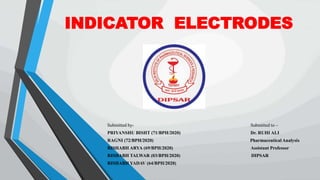
INDICATOR ELECTRODE
- 1. INDICATOR ELECTRODES Submitted by- Submitted to – PRIYANSHU BISHT (71/BPH/2020) Dr. RUHI ALI RAGNI (72/BPH/2020) Pharmaceutical Analysis RISHABH ARYA (69/BPH/2020) Assistant Professor RISHABH TALWAR (03/BPH/2020) DIPSAR RISHABH YADAV (64/BPH/2020)
- 2. Indicator Electrodes Definition: An electrode which is useful for measuring potential or pH of a solution is known as indicator electrode. • It is used for indicating the potential caused by some chemical species as compare to the reference electrode. • There are two types of Indicator electrodes: 1. Metallic indicator electrode 2. Ion selective electrode
- 3. Metallic indicator electrode: :These electrodes develop electric potential in response to redox reaction on the metal surface. Example: Platinum or gold are used as metal indicator electrodes. These are mainly classified into four types of electrodes used in the potentiometry. 1. First kind electrode: It is a simple metal electrode immersed in a solution containing its own ion. • These kind of electrodes are reversible with respect to its metal ion i.e., direct equilibrium with solution. e.g., if we place a copper metal in a solution containing metal ion then, Half cell reaction is Electrode potential by the activity of is Limitation: 1. Not very selective like Ag+ interferes with Cu+2 . 2. May be pH dependent. 3. Easily oxidized (deaeration required) . 4. Non-reproducible response.
- 4. 2. Second kind electrode: This type of electrode can be used for direct determination of the activity of the metal ion or the anion used in coating. e.g., if we use a silver electrode for chloride ion determination. Half cell reaction is Electrode potential is 3. Third kind electrode: It is a metal electrode assembly with the equilibrium potential being a function of the concentration of a cation, other than the cation of the electrode metal, in the solution. e.g., A mercury electrode used for the determination of the pH of calcium containing solutions. If, in addition, a small volume of a solution containing the EDTA complex of calcium is introduced, a new equilibrium is established, then Equilibrium reaction is The potential of a mercury electrode in this solution is
- 5. 4. Metallic redox indicator: Electrodes made from inert metals (Pt, Au, Pd) often serve as indicator electrodes for oxidation- reduction systems. • Electrode acts as e- source/sink for electrons transferred from a redox system in the solution. e.g., Detection of Ce3+ with Pt electrode Half cell reaction is Potential is Limitation: 1. Electron-transfer processes at inert electrodes are frequently not reversible. 2. It do not respond predictably to ½ reactions in tables.
- 6. Ion selective electrodes: It is also known as membrane electrodes. • It is a membrane that converts the activity of a specific ion dissolved in a solution into an electrode. e.g., Glass membrane is a most common example of ISE. 1. Glass membrane electrode: It is a type of ion-selective electrode made of a doped glass membrane that is sensitive to a specific ion. The most common application of ion-selective glass electrodes is for the measurement of pH .
- 7. Construction: It consist of hard glass tube, one internal electrode(usually Ag rod coated with AgCl), and reference electrode(usually calomel electrode), a sensing part of electrode, a bulb made from a specific glass(thin and semipermeable membrane), 0.1M HCl solution as internal sol., reference internal solution usually 0.1 M KCl . PROPERTIES: 1. Potential not affected by the presence of oxidizing or reducing agents. 2. Operates over a wide pH range. 3. It respond fast and function well in physiological system . 4. It is used in pH meter. 5. Very selective. 6. Long lifespan. Theory of the glass membrane potential 1. For the electrode to become operative, it must be soaked in water. 2. During this process, the outer surface of the membrane becomes hydrated. 3. When it is so, the sodium ions are exchanged for protons in the solution. 4.The protons are free to move and exchange with other ions
- 8. Charge is slowly carried by migration of Na+ across glass membrane Potential is determined by external H+ • As a result of diffusion and exchange process a potential develops on each side of glass membrane. Advantages: 1. Response is very rapid. 2. Chemically resistant to oxidizing & reducing agents, dissolved gases, salts etc. 3. When Lithia -silica glasses are used, it can be used over the entire pH range. Disadvantages: 1. It is extremely fragile. 2. Minute abrasions on the surface of the tip, damages the electrode. 3. It cannot be used with simple potentiometers, because of the high resistance.
- 9. References • https://www.slideshare.net/ragavarsha/potentiometry. • https://www.slideshare.net/ChowdaryPavani/potentiometry. • Pharmaceutical analysis volume-1 by Dr. A.V. Kasture.
- 10. Thank You..